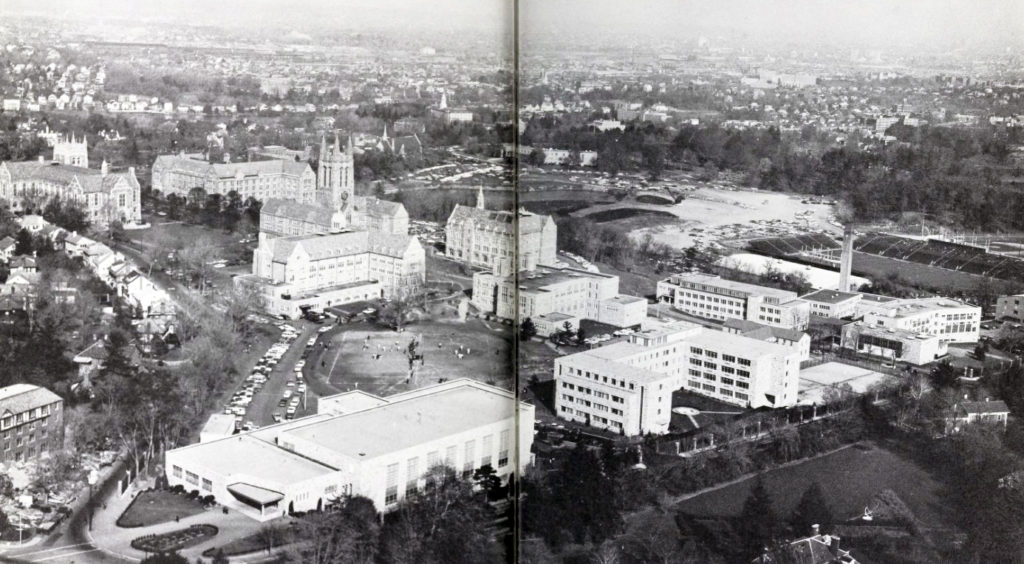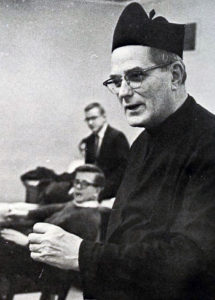“As she (sic) sits enthroned on her beautiful campus, Boston College is the beneficiary of the golden inheritance of ancient lineage and intellectual glory. Jesuit students follow in the footsteps of scholars, poets, scientists, jurists, generals, businessmen, educators, men and women in the healing arts, presidents, kings, popes, and saints.” — Undergraduate Entrance Bulletin

Printed in the 1965-66 University General Catalogue. Carney Hall looks finished, so photo is likely from 1964 or 1965.
Orientation was over, we won a football game, and classes started today in 1964.
That fall, Boston College was what some might call “old school.” Indeed, “old Catholic school.” There were rules about behavior and dress, class attendance, course requirements, etc., some of which would likely astonish, or at least surprise, a current BC student. We’ll talk in later posts about some of those rules and how some changed while we were there.
The 1964-65 University General Catalog opens its section on “The University” by describing Boston College as “one of twenty-eight Jesuit colleges and universities in the United States.” It then provides a brief history of its founding, but doesn’t go out of its way to lead the reader to see BC as particularly different, except for history and location, from the other 27 Jesuit institutions.
The “University Objective” is also not different. “As a Jesuit educational institution. Boston College shares with all other Catholic schools the purpose defined by Pope Pius XI in His (sic) encyclical on higher education: ‘To cooperate with divine grace in forming the true and perfect Christian.'”
In describing BC’s academic purpose, the author uses a particularly long, single sentence: “As an institution of higher learning, Boston College has its objective the conservation, the extension, and the diffusion of knowledge by means of the schools, colleges, institutions, and resources of the University with the purpose of imparting, in the tradition of Christian humanism, an understanding of the unity of knowledge, and appreciation of our intellectual heritage, a dedication to the advancement of learning, and a sense of personal and social responsibility as all of these are known in the light of reason and Divine Revelation.” Whew.
Vatican II, the 21st Ecumenical Council of the Roman Catholic Church, was still going on in fall 1964. It would conclude in 1965 and, along with many other social and cultural currents, bring about significant changes in the Church and institutions such as BC.
Jebbies in cassocks
Every one of the 10-member Board of Trustees in 1964 was a Jesuit. Each of the eight University Administrative Officers — President, Executive Assistant to the President, Academic Vice-President, Financial Vice-President and Treasurer, Director of Libraries, Registrar of the University, Secretary of the University, and Director of Admissions — was a Jesuit. Every dean of a school at BC, with the exception of Nursing, was a Jesuit.
(There was also an 18-member Board of Regents, composed of “civilians,” prominent local men, including, in 1964, Wallace Carroll, Peter Fuller, Ralph Lowell, and Louis Perini.)
A&S and CBA each had a “Dean of Men” who was a Jesuit. Education and Nursing had “Spiritual Counselors” who were Jesuits. Every approved student organization had a “moderator” who was a Jesuit. That fall, a young Jesuit, Edward Hanrahan, S.J., began his duties as Dean of Resident Men. We’ll talk a lot more about him in the future.
The Very Reverend Michael P. Walsh, S.J., was not only BC president, but also Rector of the Jesuit community in residence.
Of course, not everyone was a Jesuit, but their presence was nearly ubiquitous and so much more evident than at BC today.

